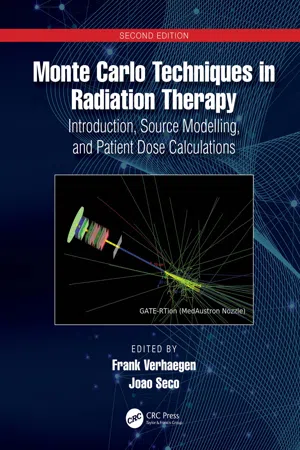
Monte Carlo Techniques in Radiation Therapy
Introduction, Source Modelling and Patient Dose Calculations
Frank Verhaegen, Joao Seco, Frank Verhaegen, Joao Seco
- 240 Seiten
- English
- ePUB (handyfreundlich)
- Über iOS und Android verfügbar
Monte Carlo Techniques in Radiation Therapy
Introduction, Source Modelling and Patient Dose Calculations
Frank Verhaegen, Joao Seco, Frank Verhaegen, Joao Seco
Über dieses Buch
About ten years after the first edition comes this second edition of Monte Carlo Techniques in Radiation Therapy: Introduction, Source Modelling, and Patient Dose Calculations, thoroughly updated and extended with the latest topics, edited by Frank Verhaegen and Joao Seco. This book aims to provide a brief introduction to the history and basics of Monte Carlo simulation, but again has a strong focus on applications in radiotherapy. Since the first edition, Monte Carlo simulation has found many new applications, which are included in detail.
The applications sections in this book cover the following:
-
- Modelling transport of photons, electrons, protons, and ions
-
- Modelling radiation sources for external beam radiotherapy
-
- Modelling radiation sources for brachytherapy
-
- Design of radiation sources
-
- Modelling dynamic beam delivery
-
- Patient dose calculations in external beam radiotherapy
-
- Patient dose calculations in brachytherapy
-
- Use of artificial intelligence in Monte Carlo simulations
This book is intended for both students and professionals, both novice and experienced, in medical radiotherapy physics. It combines overviews of development, methods, and references to facilitate Monte Carlo studies.
Häufig gestellte Fragen
I Introduction
1 History of Monte Carlo
- 1.1 Motivating Monte Carlo
- 1.2 Monte Carlo in Medical Physics
- 1.3 EGSx Code Systems
- 1.4 Application: Ion Chamber Dosimetry
- 1.5 Early Radiotherapy Applications
- 1.6 The Future of Monte Carlo
- Appendix: Monte Carlo and Numerical Quadrature
- Dimensionality of Deterministic Methods
- Convergence of Deterministic Solutions
- Convergence of Monte Carlo Solutions
- Comparison between Monte Carlo and Numerical Quadrature
- Acknowledgment
- References
It is still an unending source of surprise for me to see how a few scribbles on a blackboard or on a sheet of paper could change the course of human affairs.Stan UlamFounder of the modern Monte Carlo method, in his 1991 autobiography (1991)
1.1 Motivating Monte Carlo
